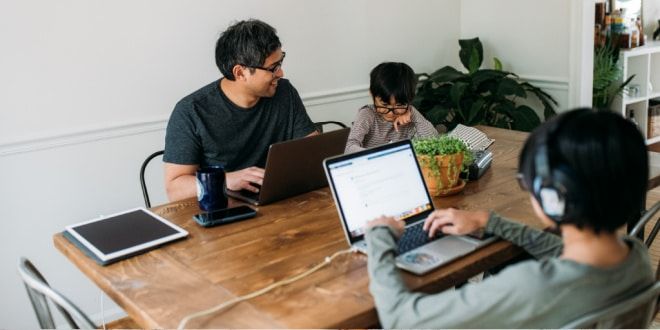By Meghan Fitzgerald of Tinkergarten
There is so much uncertainty this fall and the upcoming school year. With all the different school schedules and policies being implemented, it’s difficult to anticipate what’s to come and even harder to know how to best prepare your family. If someone had told me in March that I’d spend the next 6 months developing ways for young children to keep their distance while they play together or gathering kids online to learn outdoors, I wouldn’t have believed it. These are incredible times, and shifting realities change the game. Now, these things feel imperative.
This begs big questions for parents and educators alike. Do we anchor on what is ideal or on what is real as we support our kids during such a wild time? Do we hold kids precious and protect them from this reality, or do we help them to navigate within and adapt to it? Which will help them to thrive more in the long term? My vote: Let go of “ideal” and parent for real.
Better yet, remember that life just dumped a truckload of lemons on each of our doorsteps. The sweeter the lemonade we make, the better we do at teaching our kids to adapt to whatever life hands them.
Heading into the school year…what can we do now?
As we head into a new school year and the school system continues to grapple with social distancing guidelines, preparing curriculum for remote or hybrid learning, now more than ever, children are likely to spend part or all of their day at home. And, given that we grown ups also need to get things done, kids have to learn how to keep themselves entertained for at least portions of the day. Whether you need to join a work meeting, get things done around the house or just catch your breath, parents need ways to keep their kids engaged. And, it goes without saying, we’d love it if whatever keeps them busy also helps them learn and thrive. What’s the solution? Independent play.
The Magic (for Children AND Parents) of Independent Play
We’ve seen glimpses of it. You notice it’s been quiet in the other room for a while, you peek in and your child is totally immersed and “in the flow” of play. And it’s magical. It’s in those moments that kids are doing their best learning and are feeling happy. They are engaged in what’s interesting to them, and they are developing skills like persistence, creativity and problem-solving. You don’t have to be a trained teacher to help your kids learn to play on their own. And, you don’t even need to have the ideas! You just may need some help to get started.
At Tinkergarden, we’ve kicked off an Independent Play Training series for parents. This collection of videos and blog posts supports each of us in developing our kids’ independent play muscles. Here are a few highlights to get you started:
Start out simple
Use basic elements like an empty cardboard box, a sheet or blanket, or a bowl full of water. These give kids many more directions to go with their play than ready-made toys do. This allows kids to invent imaginative ways to use the materials and iterate as they go.
Set up a space for play
It only takes about 20 minutes to turn a corner of your home or yard into a “play center.” This can inspire days of independent play. Our favorite play centers? Mud kitchens, maker spaces, water playgrounds and art centers. Watch a 3-minute video or read more about how to set up an easy play center for your kids.
Invite rather than direct
Kids play longer when they feel like they are the ones directing the action. To make them feel “in the lead,” prompt them with, “Would you like to build a fort?” Or, you can just start doing something and that example will be enough to get kids to dive in. This video discusses that idea further. Once they are really into it, you can step away. They’ll be much more likely to stay engaged for having entered in on their own terms.
Release new materials or “ingredients” slowly and only a few at a time
The fewer the toys, the more creative and focused kids become. Lots of different options can easily overwhelm kids, and they lose interest and focus. So, rather than bombard kids with too many choices right off the bat, hold onto new materials. Release them one or two at a time, when kids seem like they might need a boost in their play.
Pick a “project” for play that can last all week—or longer
One way to get independent play going for even longer is to set up a “project” for pretend play. Some themes include pizza shops, rocket ships or big cats. To set it up, designate part of your home for project play.
Find resources that give you lots of ideas for child-led, playful learning
The more you can inspire your child to play, the more you’ll get to that happy place of an engaged child and a satisfied you. This fall, Tinkergarten will be offering Circle Time. This 8-week online session is led by an experienced Tinkergarten Leader who will guide the class through hours of joyful, purposeful play.
Let them lull
Struggle is an integral part of independent play. Enriching play is full of lulls—those moments of pause or even of boredom are when the real inspiration hits! When you feel the urge to jump in, or when kids ask for your help, count to 10 or so before you respond. You can start by asking them, “What could you do now?”
Out of everything we’re struggling to teach them, this might be the homeschool lesson they’ll benefit from the most.
Helping Kids Understand New School Policies
Humans–especially wee ones–are naturally resilient, adaptable and hopeful. Kids don’t rage against reality like we adults often do. They tend to roll with things, especially if we give them the okay and support to do so. Many of us are torn between the ideal and real–between taking and foregoing chances to help kids adjust to this moment. It’s a hard balance to strike.
Many people are leaning into this new normal while bringing their children along. We can show them how to learn new ways of doing things and make this new reality work.
Wearing a mask
Some say that it is terrible to ask a 3-year old to wear a mask, or for a child to see their teacher or parent wear a mask. It’s true that some 3-year-olds need time to get used to masks. But with practice, nearly every little kid I’ve seen takes to it just fine. There are many ways to make mask wearing feel normal and fun for kids. I have also observed kids adjust quickly to the masks around them. They learn to see a smile reflected in someone’s eyes or to use thumbs up or down to communicate feelings. Plus, learning to wear the mask teaches kids that they can adapt.
Social distancing
I’ve also heard people say that it would be psychologically damaging to ask a child to keep social distance from a friend or loved one. For sure, it feels neither natural nor easy for kids to hold back from being close and even embracing one another or their elders.
Learning about personal space is not new for young kids. From very early on, kids clearly enjoy and don’t enjoy moments when another person is in their personal space. Additionally, they learn about personal space from one another. Educators and care providers use metaphors like “personal space bubbles” to help children conceptualize personal space and have words to describe their needs and needs of others.
There are many ways to make 6 feet feel connected and sweet. We don’t need to tell kids that getting close is “bad” or “dangerous” for them to learn to keep distance. At Tinkergarten, we talk to kids about keeping our 6-foot bubble to “keep everyone safe,” rather than use fear of the virus. The very reason we are staying away is extremely sweet. It is a loving and caring act to preserve your friend’s bubble, and little kids can really get behind that idea.
Reminders are our powerful tool. Little kids do not have strong impulse control, so it will take multiple reminders. But, that is just how little kids learn–through repetition and gentle reminders. If you can make the reminders fun, shame-free and kid-centered, it’s actually enjoyable to teach and watch your kids learn to mind their space bubble. For example, we love playing like lobsters at Tinkergarten – backing up just a bit to help kids learn to keep their space bubbles in place.
Free educational resources for kids and resources for parents
Screens can play an important role in supporting our kids. If you do leverage media in your mix, it helps to know you are picking high quality resources that are well designed to engage young children. How do you find such resources? Here are some of our favorites:
- Wide Open School—Common Sense Media has long helped us evaluate appropriate media for kiddos. They have pulled together online resources to support parents in providing their children with excellent resources, each matched for different learning domains.
- Khan Academy Kids—The creators of Khan Academy have designed a series of apps, games, content, live experiences and printable resources to engage young children in interactive learning.
- National Geographic—Deepen even young children’s curiosity and love for the natural world by watching and learning about animals all over the world.
- Tinkergarten Online Circle Time—Starting in September, each week, a certified Tinkergarten Leader engages each child, guiding the group through a social experience filled with beloved Tinkergarten songs, movement, sharing and play. Parents get expert-designed activity guides, a live demo, and Q&A with their Leader to help their child unlock the power of purposeful, independent play at home.
Supporting Older Kids
Our work at Tinkergarten focuses on younger ages, but the former middle school teacher in me knows that older children need to balance this new world of learning just as much as our littles do. This is especially true if your older child is online for learning all day. Our bodies do not stop needing to move as we get older. Kids just get better at hiding how much they need it! Here are a few helpful ways to support your big kid this fall:
- Screen time: Talk with older children about what role screens will play in their day to day. Make a plan for how to balance screen time with green time. Want a place to start? Read this article, then work together with your child to decide on how you will limit screen time. Build in family no-screen zones and learn more helpful ways to manage the impact of screens.
- Outside time: Kids never stop needing recess … it just looks different as your child ages. Set a goal with your child of at least 2 hours per week, or, better yet, an hour each day. Explore ways to give older kids real-life tasks like biking to the store, walking to mail a letter to a friend or taking their learning outdoors to help them build in outdoor time.
- Friend time: Big kids may be better at using screens to connect with people, but there is still no replacing in person time. Encourage older kids to get together with friends in person. We know that outdoor activities are inherently safer in terms of virus spread. Help kids think of outdoor spaces in which they can meet up with friends. Activities like bike riding, going on walks or meeting up to hang in a local park can build independence, get kids outdoors and allow them to unplug while connecting with friends.
Supporting YOU
The stress of COVID-19 is intense, and it’s especially hard on parents. Invest whatever time you can to caring for yourself. Even ten minutes a day to get outside for a walk, take some deep breaths or even just listen to beautiful music can help us reset. Apps like Shine or Headspace can also help anyone who wants a little coaching to develop a meditation practice.
When in doubt, go outside!
At times like these, we want our kids to reap the physical, mental, emotional, and educational benefits of time outside more than ever. Even 2 hours per week can deliver those benefits. Try to take whatever you are doing outdoors as much as you can. If it’s hard to get outdoors, find some tips for how to find creative ways to get outside or bring the outdoors in. Every special moment outside is a win! This too shall pass. When we look back, our families will remember the little, sweet moments we managed to create in the midst of so much challenge.
















